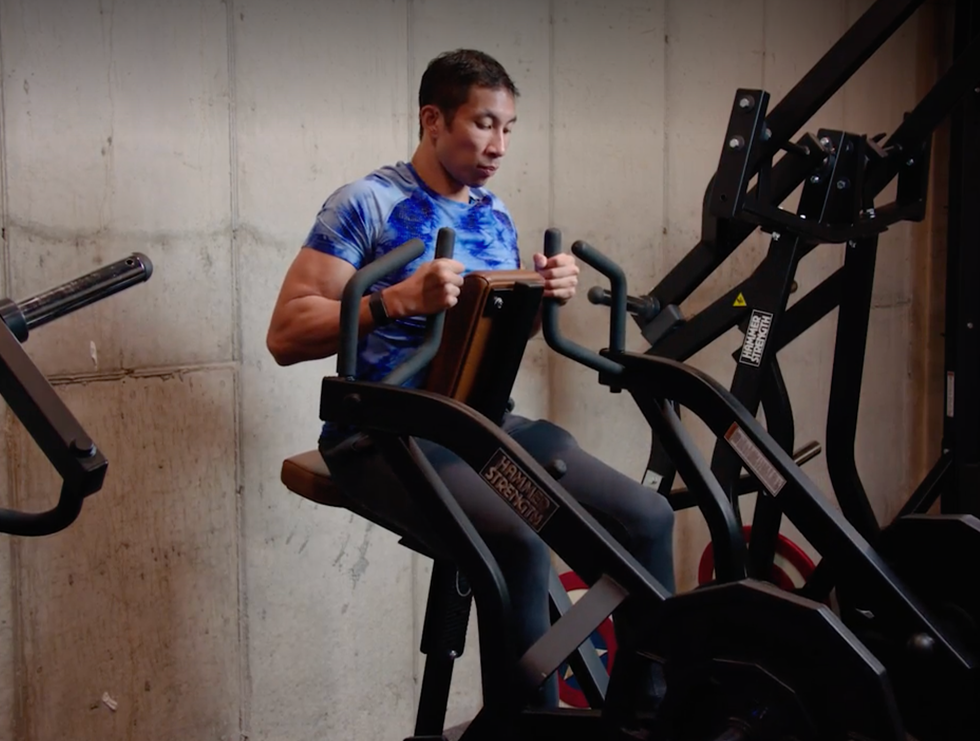IF YOU WANT to build a big back, you’re going to need to do plenty of heavyweight rows. Unfortunately, that can often mean that you’ll wind up exposing your lower back to the strains and stress that comes from the common bent-over position you’ll use for key row variations.
If that’s the case, one piece of equipment that you’re probably already familiar with—the Hammer Strength row machine—will be an invaluable addition to your back training routine. If you haven’t already started using the machine, says Men’s Health fitness director Ebenezer Samuel, C.S.C.S., it’s time to work it in to your routine.
Why? Your lower back is in a safer and more stable position throughout the movement. This allows you to place your focus on the squeeze of your shoulder blades, which is where you’ll be reap the most muscle-building gains. This back-training benefit allows you to gain a greater lat stretch while still being able to incorporate more poundage—but with a lot less stress in the lower back.
“I can’t get that on a dumbbell row,” Samuel says. “I can’t get that on a barbell row, especially from going heavy. I can get that here. And that’s one of the reasons that I really wind up loving the Hammer Strength row.”
Which Muscles You Use With the Hammer Strength Machine
You may think that a Hammer Strength row machine is good just for hitting your lats, but you’re also nailing a few additional muscle groups in your routine, including:
- Rear Delts
- Biceps
- Forearms
- Core
- Lower Back
Who Should Be Using the Hammer Strength Row Machine
- Bodybuilders
- Strength athletes
- Beginner lifters
Because the Hammer Strength row machine is so simple, this movement benefit anyone who’s involved in any sort of weight training routine. Bodybuilders love this move for its low-impact nature, which allows you to target your muscles without much technical challenge. You can load up large amounts of weight, so strength athletes are able to make big gains as well. Even if you’re into functional fitness, this machine allows you to work with a larger load—which can carry over to greater numbers with barbell and dumbbell movements. The Hammer Strength row is a fantastic option for beginners to get acquainted with the basic mechanics of the row without the challenge of maintaining strong posture.
Setting Up for the Hammer Strength Row Machine
This exercise seems simple—just sit and row—but like any other movement, the Hammer Strength row machine row can be a little more nuanced than that.
The first thing any user should be aware of is seat positioning. For starters, your best bet is to line yourself mid-chest with the pad. This is important because you’ll rely on the pad for a few reasons:
- The pad will provide you with physical feedback. You’ll notice when your chest starts coming off of it mid lift; that may mean you could be losing control of the exercise
- By preventing your chest from moving too far forward, you’ll still be able to extend your lats a little deeper, which will provide a great stretch to the muscle.
You don’t just have to sit and row either, as the Hammer Strength row machine can be done standing as well, from either a normal shoulder-width stance or even a staggered stance.
Grip
You’ll notice that the Hammer Strength machine provides you with a few different handles for mixing up your grip from time to time—which means it’s really to come up with a wrong way to grip this.
You can approach your hand positioning in a number of ways. For max strength, go with the neutral (palms facing each other) grip. This is going to engage your lats a bit more than the others while allow you to pull heavier weight.
You can also take a wider grip, which will require less weight but will provide a greater shoulder blade squeeze than other grips. You will also actually switch the muscle focus slightly to your rear delts as well. Another option is to go both hands or bi-lateral, which is a great way to really go heavy.
How to Do a Hammer Strength Machine Row
- With the seat aligned so your chest is secure with the chest pad, select your choice of hand positioning.
- Once you figured your grip position, take a deep breath and brace your abs as you drive your chest into the pad.
- Squeezing your glutes, let the bar pull you forward slightly, giving you a nice additional stretch.
- From there, pull back each handle as you drive your chest into the pad, slightly creating a hinge into the movement.
- Squeeze your shoulder blades—about two seconds should work—then return to start position.
How to Do the Hammer Machine Row in Your Workouts
Again, because it’s such a versatile exercise, the Hammer Strength row machine can be done either at the start or end of your back session or upper body workout. If you’re using this at the beginning your workout, aim to go heavy, with about four sets of six to 10 reps each. As a finisher, you can pull to fatigue—probably more effective with lighter weight than at the start of a workout—for about three sets of 15 to 20 reps.
Jeff Tomko is a freelance fitness writer who has written for Muscle and Fitness, Men’s Fitness, and Men’s Health.
Brett Williams, a fitness editor at Men’s Health, is a NASM-CPT certified trainer and former pro football player and tech reporter who splits his workout time between strength and conditioning training, martial arts, and running. You can find his work elsewhere at Mashable, Thrillist, and other outlets.



Comments are closed.